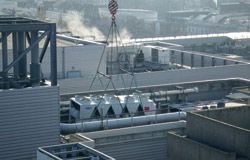Andrew Keogh, engineering manager with Carrier Air Conditioning, discusses how one simple S could help companies save thousands of pounds when it comes to installing air con.
The addition of one simple letter could help companies save thousands of pounds when it comes to installing an air conditioning system. If more companies focused on a Seasonal Energy Efficiency Ratio, as opposed to the traditional Energy Efficiency Ratio, significant savings could be made.
Air conditioning equipment with an EER of 4 can be up to 25 per cent more expensive than one with an EER of 3, and with building regulations requiring a minimum 20 per cent improvement in the energy performance in air conditioning services, many companies simply bite the bullet and get out the cheque book.
The problem with EER is that all tests are undertaken at an ambient temperature of 35°C. Unfortunately, we in the UK enjoy those temperatures only a couple of times a year. It seems unusual that we base our scoring system on a standard ambient temperature which is rarely achieved in the real world.
SEER, on the other hand, is a much more accurate measurement. SEER measures the efficiency of the chiller at each of the four seasons to give a more representative measure of real-life performance. This is a much better measure as we have six months of the year (spring and autumn) when temperatures are essentially flat and where cooling loads are low.
In a nutshell, the SEER rating is more accurate and reflects overall system efficiency on a seasonal basis, while the EER reflects the system's energy efficiency at peak day operations. That's the theory, but what application does it have when designing and commissioning?

Equipment with an EER of 4 can be up to 25 per cent more expensive than one with an EER of 3
When chillers were specified on their full load EER at the projected operating conditions during the design stage, they would typically achieve an EER of around 3. Now that the building regulations allow SEER, the number will typically be around 4.3, already an apparent improvement of 43 per cent.
Of course, many buildings are served by systems which have several chillers, possibly of different sizes and differing technologies. Determining the overall SEER for such systems requires a much more detailed analysis that should include the degree of over-sizing of the total installed capacity, the sizing of individual chillers, the EERs of individual chillers, the control mode of the multiple chillers and the load profile of the proposed cooling load. Little wonder that many designers think it is a lot simpler just to focus on the EER.
However, help is at hand. Carrier Corp, for example, has software capable of undertaking this analysis. The results can be outstanding as the System SEER can often be in excess of 5.5, more than 80 per cent better than the basic chiller EER.
The issue is real (as opposed to nominal) efficiencies and other relatively simple changes can further improve system efficiencies. A few examples of this include:
• When a packaged air-cooled chiller is running, it rejects large quantities of heat to the surrounding air. It is quite likely that at the same time a gas or electric heater is being used to provide hot water in the building for toilets and kitchens. Chillers are now available with heat recovery exchangers that allow the heat previously rejected to the atmosphere to be 'recycled' to satisfy some or all the demand.
• It is now cost effective to specify variable speed drives for key parts of the air conditioning system. For large buildings, a variable speed drive centrifugal compressor chiller can offer part load COPs in excess of 10, a huge improvement over fixed speed units.
• Variable speed chilled water distribution pumps can yield tremendous savings, not least because these devices run continuously, whatever the size of the required cooling load.
It is, therefore, more important than ever for system designers to collaborate with equipment suppliers with the necessary expertise and analytical tools to be able to evaluate the possible options to find the most appropriate, efficient and cost effective.